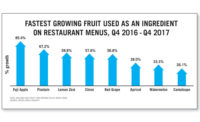Restaurant Menus: Balancing Act
Operators contrast traditional with unique, healthful and indulgent—all to satisfy varying needs and occasions

Award-winning Chef Chris Shepherd introduced the Impossible Burger at his Houston restaurants Underbelly and The Hay Merchant. The move taps two trends: growing interest in vegan and vegetarian entrée options, as well as consumer love for burgers
SOURCE: IMPOSSIBLE FOODS / WWW.IMPOSSIBLEFOODS.COM

Popular Pairing: Cheesecake Factory’s Korean Fried Cauliflower—offered as a side or snack—features crispy cauliflower tossed with sweet and spicy sauce, toasted sesame seeds and green onion.
SOURCE: THE CHEESECAKE FACTORY INC / WWW.THECHEESECAKEFACTORY.COM

Peet’s Coffee greeted spring with three new honey-inspired drinks. “Honey has experienced steady growth in recent years, especially with consumers craving artisanal products,” says Patrick Main, senior R&D manager, Peet’s Coffee. “More and more, we have seen it paired with a variety of foods. With coffee, its unique and full-bodied flavor profile draws out the complex tonalities of our beans to produce a harmonious cup.”
SOURCE: PEET’S COFFEE & TEA / WWW.PEETS.COM

Southern Comfort: Dessert trends include Southern flavors, comfort foods and cookie dough. The Yard Milkshake Bar, Gulf Shores, Ala., serves up specialty milkshakes and a wide selection of edible cookie doughs for “build-your-own” options.
SOURCE: THE YARD MILKSHAKE BAR / WWW.THEYARDMILKSHAKEBAR.COM




Restaurant operators continue to face what seem to be contradictory demands from consumers. Patrons want to be able to customize dishes, but oftentimes they’re in a hurry and can get overwhelmed by too many options. Sometimes they want to eat healthfully, while other times they want to indulge. And they seek uniqueness and modernity, but also like a little nostalgia, now and then.
Responding to each of these demands can be difficult, but the task is critical for brands that aim to differentiate and capture return visits. Concepts must pick and choose their menu mix wisely and are doing so by employing different approaches to the balancing act within each meal part.
Appetizers
Appetizers and desserts often are the first items to go when consumers are looking to cut back for health or monetary reasons. However, diners continue to order appetizers, not just as a starter, but also as an entrée or snack.
The popularity of snacking makes appetizers an appealing option for these occasions, with 66% of consumers saying they occasionally purchase appetizers as snacks, according to Technomic’s latest “Snacking Consumer Trend Report.”
To accommodate, restaurants are menuing more bite-sized and shareable starters, such as casual-dining chain Cheddar’s Scratch Kitchen’s three different types of toasts. Each can be ordered individually or together, as part of a sampler featuring each toast type: Roasted Vegetable, Buffalo Chicken and Smashed Avocado & Pico.
Late last year, Wienerschnitzel returned its miniature corn dogs, available in packs of six, 12 or 20. And Fogo de Chao recently added a small-bite protein dish to its permanent menu: Braised Beef Rib Sliders feature Brazilian Xingu beer-braised beef topped with caramelized onions and smoked provolone, served on a brioche bun.
Just as some operators are altering entrée items to create bite-sized appetizers, others are using appetizers to test out new, bold flavors and global ingredients. Consumers may be more willing to try out unfamiliar flavors in an appetizer over an entrée, as they’re typically less expensive—so less risky to order.
For example, a number of top chains have turned to poke, especially as many independent and emerging chain concepts specializing in the raw fish are popping up around the country. Benihana recently added a customizable poke appetizer with a choice of tuna, salmon or a mix of the two with onion, green onions, seaweed salad and sesame seeds, tossed with sweet soy sauce and garnished with cucumber slices and a lemon wedge. Yard House offers a different take on the poke trend with its newly added Poke Nachos with marinated raw ahi, avocado, cilantro, serranos, green onions, nori, sesame seeds, sweet soy, sriracha aïoli, white truffle sauce and crispy wontons.
An appetizer with poke allows consumers to be adventurous, without the commitment of ordering an entrée. While many restaurants are simply reducing the sizes of their appetizer dishes or making them more shareable, some are taking more risks on this side of the menu to entice consumers looking to try something new.
Sides
New doesn’t have to mean unfamiliar, as restaurants continue to seek a balance between satisfying adventurous consumers and those who like to order what they know. To cater to these different needs, operators are adding unique spins to traditional items.
Fries are a longtime customer favorite that have seen few changes in the past but are now receiving more attention from operators looking to differentiate. Restaurants are experimenting with global sauces and spices, poutines, condiments beyond ketchup and non-potato based versions, such as yucca or avocado fries. Mentions of fries have increased the most at fast-casuals (43.8%) and quick-service restaurants (22.9%), though penetration is heaviest at traditional casual-dining operators, according to Technomic’s MenuMonitor.
Last fall, Carl’s Jr. and Hardee’s added Budweiser Beer Cheese Bacon Fries to its menu, when it launched a beer-infused burger. And fellow quick-service chain Taco Bell is testing loaded fries on its menu. The seasoned fries are topped with nacho cheese, beef, tomatoes and sour cream. Relish Burger Bistro in the Westin Seattle has added a premium sauce—cilantro crema—to its traditional fry recipe.
Operators are also looking to differentiate their sweet potato fries, which have been growing mentions at top chains over the years. Operators are offering new condiment pairings with their sweet potato fries, such as maple-bacon cream dip at Yard House, and Sriracha Chili-lime sauce at Applebee’s.
Just as Taco Bell is exploring how to offer fries in a way that aligns with its brand, other operators are offering different types of fries with non-potato bases, as a way to provide an enduring favorite, while staying true to their concept. Washington, DC, food truck and brick-and-mortar Rito Loco, for example, offers two types of fries that stay within its Latin fusion bounds: yucca fries and avocado fries.
Operators also are taking this approach with slaws, incorporating ingredients such as apple and jicama to align with their brand. Pancheros Mexican Grill recently announced limited-time seasonal tacos, including one with carnitas and apple slaw. Rock Bottom Restaurant & Brewery unveiled earlier this year its Lighter Choices menu, which featured Grilled Beer-Glazed Chicken, served with apple and kale coleslaw. Texas-based, full-service concept Wild Salsa offers a crisp, light jicama-mango slaw to complement the many spicy dishes on its menu.
Lighter sides are a hit with consumers, especially those looking for an overall healthful meal or to balance more indulgent entrées, according to Technomic’s recent “Left Side of the Menu: Soup and Salad Consumer Trend Report.” Salad consumption is trending up, and operators are adding salads that consumers can order as a side, snack or starter. Starbucks is testing a mercato (marketplace) lunch menu at Chicago locations with a variety of side salads, including Cauliflower Tabbouleh with arugula; Cage-Free Eggs & Seasoned Grains with tomatoes and spinach; and Roasted Carrot & Kale with preserved lemon yogurt, farro and almonds.
Starbucks’ Roasted Carrot & Kale salad, in particular, increasingly is appealing to younger consumers. A third of 18- to 34-year-old consumers say they are interested in grain-based salads, such as the ones from Starbucks. Fogo de Chao also recently hopped on the trend, with its spring Lentil Quinoa Salad, featuring quinoa, green lentils, diced red onion, red bell peppers, chopped parsley and basil.
Entrées
Many operators use vegetable sides as a light, healthful balance to more indulgent entrées. But some operators are menuing a few mix-and-match vegetable sides as entrées to appeal to consumers’ increasing desire for variety and choice with their mains.
Data in Technomic’s “Center of the Plate: Seafood & Vegetarian Consumer Trend Report” shows that half of consumers would like restaurants to offer a wider variety of vegetarian entrées. After finding that guests were ordering numerous side veggies together as their main dish, Alabama chain Full Moon Bar-B-Que began offering the option permanently, selling three vegetables for $7.99 and four for $9.99.
Speaking of vegetables as a main course, cauliflower still is in the spotlight. The familiar vegetable provides a mild base to add different flavors and textures. The Cheesecake Factory has added to its menu a Pan-Roasted Cauliflower Steak—a large pan-roasted cauliflower with brown butter, herbs, capers and Parmesan, served with spinach and couscous sautéed with corn and tomato. Buffalo Wings & Rings recently launched Cauliflower Wings, and Hard Rock Cafe late last year debuted a limited-time Cauliflower Burger.
To meet increasing calls for vegetarian and vegan entrées, brands can draw inspiration from cuisines with rich vegan repertoires, like Indian or Ethiopian. Pret A Manger’s recent menu additions include vegetarian and vegan options with global flavors, such as the Harissa Chickpea Mezze Pot, a vegetarian offering of harissa-coated chickpeas with dukka spice, mint leaves and olive oil, served over Greek yogurt.
For many consumers, social responsibility and environmental concerns drive their vegetarian or vegan diets. But this aligns with trends for meat entrées, as well, as many consumers are increasingly seeking “better” meats. “Better” can include transparent and clean labels; sustainably raised proteins; fresh, not frozen meats; and natural seasonings and sauces.
Better chicken sandwiches, like Bojangles’ Famous Chicken ’N Biscuits’ limited-time Chicken Supremes Sandwich, are popping up on menus. The sandwich features the brand’s chicken fingers, which are tenderloins of whole breast meat with brown sugar, cayenne hot sauce and molasses—for a hot yet sweet kick.
Increasing the consumption of both beef and pork, often viewed as less healthful compared to poultry, according to Technomic’s “Center of the Plate: Beef & Pork Consumer Trend Report,” hinges on restaurants’ ability to innovate. Operators are drawing inspiration from global preps and ingredients, such as Filipino adobo. Modern twists on classic dishes also are helping to differentiate and broaden appeal.
Burgers are a perfect example of operators taking a perennial customer favorite to the next level with global or other nontraditional variations. For example, Carl’s Jr. is testing a Korean BBQ Burger. Available at select locations in Garden Grove and Santa Ana, Calif., the new burger features a beef patty topped with Korean-style barbecue beef and Asian coleslaw.
Pimento cheese is a Southern staple that’s seen resurgence on burgers. Fatz Cafe recently added new menu items, including The Spartanburger, featuring a grilled beef patty, Carolina jalapeno-pimento cheese, housemade bacon jam, tomato, lettuce, caramelized onions and sriracha mayonnaise. Late last year, Bad Daddy’s Burger Bar also introduced a burger with pimento cheese—the PB Pimento Crunch Burger was topped with pimento cheese, housemade kettle chips, peanut butter and bacon-bourbon jam on a brioche bun.
Desserts
Southern flavors also are having a moment on dessert menus. Earlier this year, Back Yard Burgers added Pecan Cobbler to its menu. The dessert features pecans, vanilla extract and brown sugar baked in a crust. Late last year, LongHorn Steakhouse added a Louisiana-style bread pudding dessert for winter. The Chocolate Banana Bread Pudding had chocolate chips, topped with warm Jim Beam caramel, bananas and vanilla bean ice cream.
These Southern desserts and other comfort food sweets also spark a little nostalgia for diners. Cookie dough is one comfort food sweet that’s had a resurgence on menus this year, bringing diners back to their childhoods. Little Donkey in Cambridge, Mass., earlier this year started serving cookie dough on a beater. The dessert features pasteurized egg yolk, milk espuma and cocoa nibs.
Cookie dough is also making a comeback beyond its presence in ice cream. Papa Murphy’s Pizza introduced limited-time, take-and-bake Chocolate! Chocolate! Chocolate! Cookie Dough cookies, which feature chocolate cookie dough with white and semisweet chocolate chips.
In contrast to these classic desserts are the photo-worthy dessert crazes, like Starbucks’ Unicorn Frappuccino—and its alternative, Goth-inspired black ice cream like that of Austin, Texas-based Cow Tipping Creamery. Its version is soft serve colored with black ash that’s made with activated charcoal. Around the same time, Los Angeles ice cream shop Little Damage introduced its own take on the counter-trend: almond-charcoal soft serve that’s even swirled into a black cone.
Even more over-the-top are Instagrammable dessert combinations and mashups, like the Chimney Cones from Garden Creamery in San Francisco. The cones, adapted from a Hungarian pastry, resemble churros. They’re made with sweet yeast dough that’s baked around a spindle, then rolled in cinnamon sugar. The small shop offers eight vegan versions of ice cream made with coconut milk, including Thai Tea and Orange Creamsicle, as well as dairy flavors, such as Black Sesame and Banana Salted Caramel. And, last fall, Dunkin’ Donuts began offering customizable doughnut sandwiches, with a choice of Baskin-Robbins’ ice cream and fudge in the middle.
Beverages
For many concepts, indulgent and over-the-top dessert offerings may not align with their brand and menu; beverages can serve as an alternative for operators to satisfy consumers’ sweet cravings. Many restaurants are positioning drinks as better-for-you options by using natural sweeteners like honey and maple syrup. About 60% of consumers say they would be more likely to purchase a drink that’s naturally sweetened, according to Technomic’s “Beverage Consumer Trend Report.”
This spring, Peet’s Coffee & Tea added a number of drinks sweetened with honey, including the Honey Macchiato, Honey Cortado and Honey Matcha Tea Latte. Maple-sweetened beverages, such as IHOP’s Maple French Toast Hot Chocolate and Bruegger’s Bagels’ French Toast Coffee with maple syrup, appeared on menus this past winter as temperatures dipped.
Heath concerns drive demand for functional beverages, such as kombucha or drinks with ingredients like acai or matcha. Pret A Manger recently added a Matcha Latte made with steamed milk or almond milk and Panatea (brand) matcha. These types of beverages can even serve as snacks for consumers or replace meals altogether. Younger consumers, in particular, are more likely to seek out beverages specifically targeted to functional benefits. For example, these consumers show interest in matcha (high in antioxidants) and kombucha (which aids digestion).
Striking a menu balance can take different forms for various concepts, depending on their focus, menu and customer base. While it can seem daunting as consumers’ needs vary, restaurant brands that provide balanced menus are more likely to capture occasions and keep guests coming back for more.
Originally appeared in the August, 2017 issue of Prepared Foods as Restaurant Menus: Balancing Act.
Looking for a reprint of this article?
From high-res PDFs to custom plaques, order your copy today!









